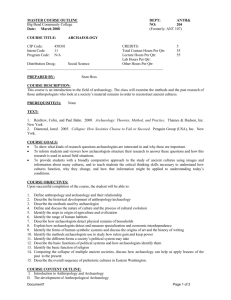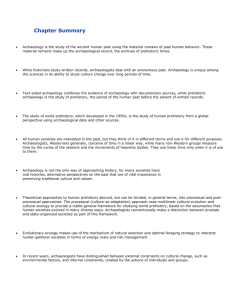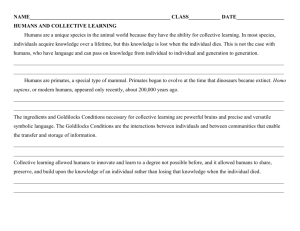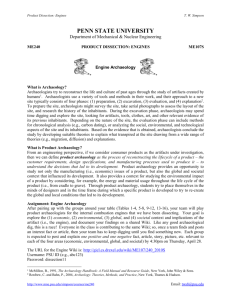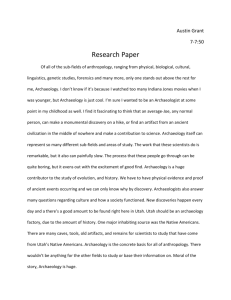Archaeology and Anthropology - In Search of the Past
advertisement
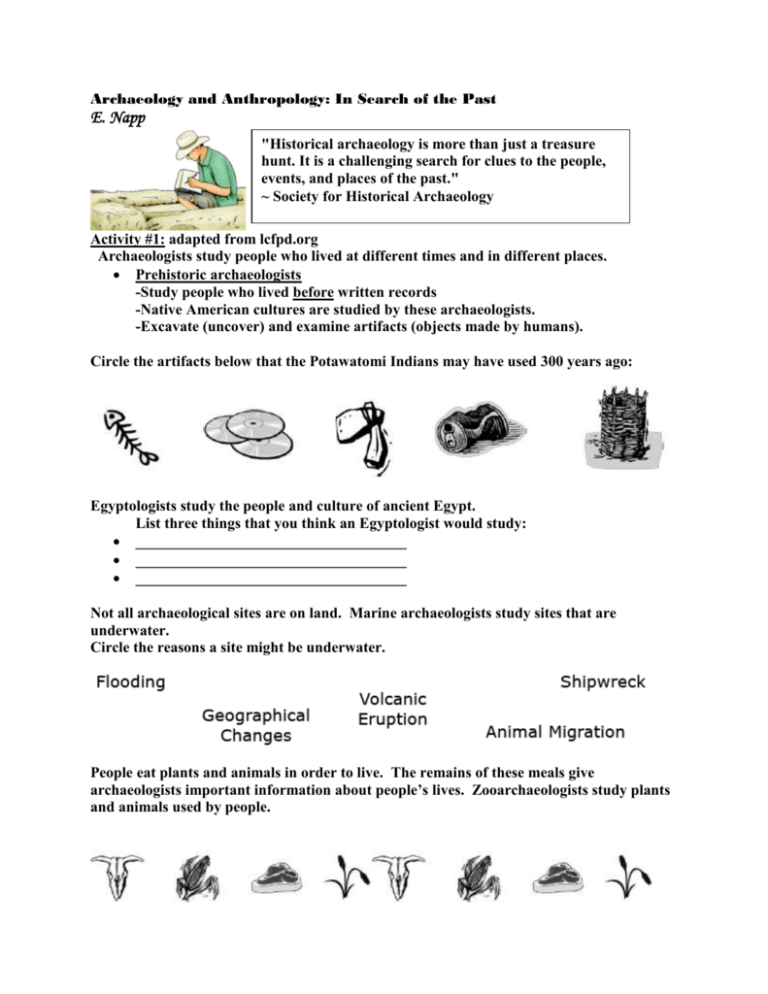
Archaeology and Anthropology: In Search of the Past E. Napp "Historical archaeology is more than just a treasure hunt. It is a challenging search for clues to the people, events, and places of the past." ~ Society for Historical Archaeology Activity #1: adapted from lcfpd.org Archaeologists study people who lived at different times and in different places. Prehistoric archaeologists -Study people who lived before written records -Native American cultures are studied by these archaeologists. -Excavate (uncover) and examine artifacts (objects made by humans). Circle the artifacts below that the Potawatomi Indians may have used 300 years ago: Egyptologists study the people and culture of ancient Egypt. List three things that you think an Egyptologist would study: ____________________________________ ____________________________________ ____________________________________ Not all archaeological sites are on land. Marine archaeologists study sites that are underwater. Circle the reasons a site might be underwater. People eat plants and animals in order to live. The remains of these meals give archaeologists important information about people’s lives. Zooarchaeologists study plants and animals used by people. Which parts of animals and plants do archaeologists find? ________________________________________________________________________ Archaeologists are a principal source of knowledge of prehistoric, ancient, and extinct cultures. The word “archaeology” comes from the Greek archaia (“ancient things”) and logos (“theory” or “science”). The archaeologist is first a descriptive worker: he has to describe, classify, and analyze the artifacts he studies. But the main aim of the archaeologist is to place the material remains in historical contexts, to supplement what may be known from written sources, and, thus, to increase understanding of the past. Ultimately, then, the archaeologist is a historian: his aim is the interpretive description of the past of man. Archaeologists enrich the present by providing knowledge of the experiences and achievements of people who lived in the past. Because it concerns things people have made, the most direct findings of archaeology bear on the history of art and technology; but by archaeology can also provide information about the society, religion, and economy of the people who created the artifacts. Also, it may bring to light and interpret previously unknown written documents, providing even more certain evidence about the past. But no one archaeologist can cover the whole range of man’s history, and there are many branches of archaeology divided by geographical areas (such as classical archaeology, the archaeology of ancient Greece and Rome; or Egyptology, the archaeology of ancient Egypt) or by periods (such as medieval archaeology and industrial archaeology). Writing began 5,000 years ago in Mesopotamia and Egypt; its beginnings were somewhat later in India and China, and later still in Europe. The aspect of archaeology that deals with the past of man before he learned to write has, since the middle of the 19th century, been referred to as prehistoric archaeology, or prehistory. In prehistory the archaeologist is paramount, for here the only sources are material and environmental. (Adapted from Encyclopedia Britannica) Questions: What is the principal source of knowledge of prehistoric, ancient, and extinct cultures? _______________________________________________________________________ What does the word “archaeology” mean in Greek? _______________________________________________________________________ What is the first task of archaeologists? _______________________________________________________________________ What is the main aim of archaeologists? _______________________________________________________________________ How do archaeologists enrich the present? _______________________________________________________________________ What is classical archaeology? _______________________________________________________________________ When and where did writing begin? _______________________________________________________________________ Define prehistoric. ________________________________________________________________________ What is anthropology? Anthropology is the study of humans, past and present. To understand the complexity of cultures across all of human history, anthropology draws and builds upon knowledge from the sciences. Historically, anthropologists in the United States have been trained in one of four areas: socio-cultural anthropology, biological/physical anthropology, archaeology, and linguistics. Anthropologists often integrate the perspectives of several of these areas into their research, teaching, and professional lives. (Adapted from aaanet.org) Socio-Cultural Anthropology: Biological/Physical Anthropology: Archaeology: Linguistics: Examines social patterns and practices across cultures Special interest in how people live in particular places and how they organize, govern, and create meaning. Concerned with similarities and differences and its attention to race, sexuality, class, gender, and nationality Seeks to understand how humans adapt to diverse environments Interested in human biological origins, evolution and variation Give primary attention to investigating questions having to do with evolutionary theory Studies past peoples and cultures, from the deepest prehistory to the recent past, through the analysis of material remains, ranging from artifacts and evidence of past environments to architecture and landscapes Material evidence, such as pottery, stone tools, animal bone, and remains of structures, is examined the comparative study of ways in which language reflects and influences social life Shares with anthropology in general a concern to understand power, inequality, and social change, particularly as these are constructed and represented through language and discourse Questions: What is of special interest to Socio-Cultural Anthropologists? ________________________________________________________________________ Which type of anthropology emphasizes evolution? ________________________________________________________________________ What do archaeologists study? ________________________________________________________________________ Which type of anthropology studies the ways in which language reflects and influences people? ________________________________________________________________________ Anthropology in Action: (Adapted from schools.woboe.org) Imagine that you are an anthropologist. It is your job to analyze the bones, tools, and clothing of a very old body. In addition you must examine information about the site in which the body was found to help solve the mystery of the person, his life, and his death. The Evidence: The body was found within 37 miles of where you and your colleagues believe he grew up. His joints had very little deterioration, which means he probably did not do very much physical activity in his life. Maybe he was a religious leader such as a priest or a Shaman. He may have been assassinated in a power-play conflict. He was shot with an arrow in the back because the tip of the arrow was found when doctors and scientists X-rayed the body. He was not facing his attacker. Perhaps some of the village people did not like his politics or religious leadership or service to the community. Maybe one of his followers had a disagreement with him and murdered him. He also had some sort of mushrooms known for their medicinal value with him. A Shaman (religious leader) often used his powers, plants and other medicinal remedies to try and cure people. This could prove that he was a leader who may have been disliked by one or more people. Maybe he tried to cure someone and did not succeed leaving family loved ones grief-stricken and angry. He also had a copper axe with him. Copper was expensive though. It is possible that only a leader would own such a tool. And if it was so valuable, wouldn’t a robber have taken it after he killed his victim. No –you are sure that this was not an accident or a robbery—this was an assassination. Fill in the Graphic Organizer Below: Death of the Recovered Body List the evidence from the actual body: List the objects found on the body: List the conclusions from the evidence:


